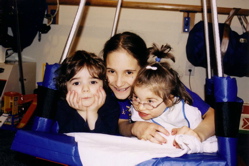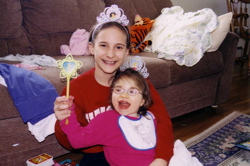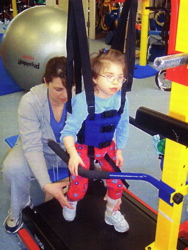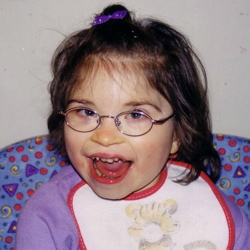| More About Amanda from her Mom, Lee | |
|
|
A deletion in the 18th chromosome is very rare. Since the world of medicine has not been able to determine which genes are on each chromosome yet, we do not know which genes Amanda is missing. We do know that she has developmental and cognitive delays, a pulmonary stenois (a mild heart anomaly), upper respiratory problems, very low muscle tone, and one of her ear canals is fused closed, . Because her muscle tone is low she does not have the strength to sit, walk, and grasp toys on her own. |
With therapy, Amanda is getting stronger and trying to learn how to do these every day things. She wears orthodics on her legs to give her support and to try and correct her growth. Her growth is slow. She will be 7 years old in June and she weighs only 30 pounds. Amanda’s brain development is not that of a 7 year old. It is currently at the level of a normal 18th month old. Amanda communicates and expresses her feeling with sounds and facial expressions. She has come a long way in communicating with us.
Amanda just recently stopped eating baby food! Congrats to Amanda for graduating to table food. This still is not an easy task – some foods still need to be pureed or cooked to extreme softness. She has gained weight and she loves trying all the new tastes. Because she has a slow digestive system each new food has to be tried in small quantities. She eats orally and can drink from a cut out cup with assistance and from a straw. She has a feeding tube for supplemental feedings for extra nutrients. Her supplemental feedings consist of 24 ounces of baby formula to be sure she is getting all the correct nutrients for her body and brain development. This is an expense that most parents can’t wait to be done with when their babies are old enough. We are still plugging along with buying formula for her.
Amanda’s eyesight has improved since birth. Her eyesight took longer to develop than most babies. She has had tear duct problems that she seems to be growing out of. She is being followed every three months for signs of glaucoma. She recently got glasses and they have made a big difference. It is easy to see she can see better. Her attention is better at school, she now looks at people as if taking them in, and she looks and watchers her surroundings with interest.
Because of her upper respiratory problems Amanda is given a nebulizer treatment twice a day sometimes three times a day when things act up. Because she is not as active as most children by running, walking, and other movements any kind of respiratory problem takes longer to go away. Any kind of illness is a big deal for Amanda because she is not strong enough to fight them off. Her immune system does not fight as hard as ours.







